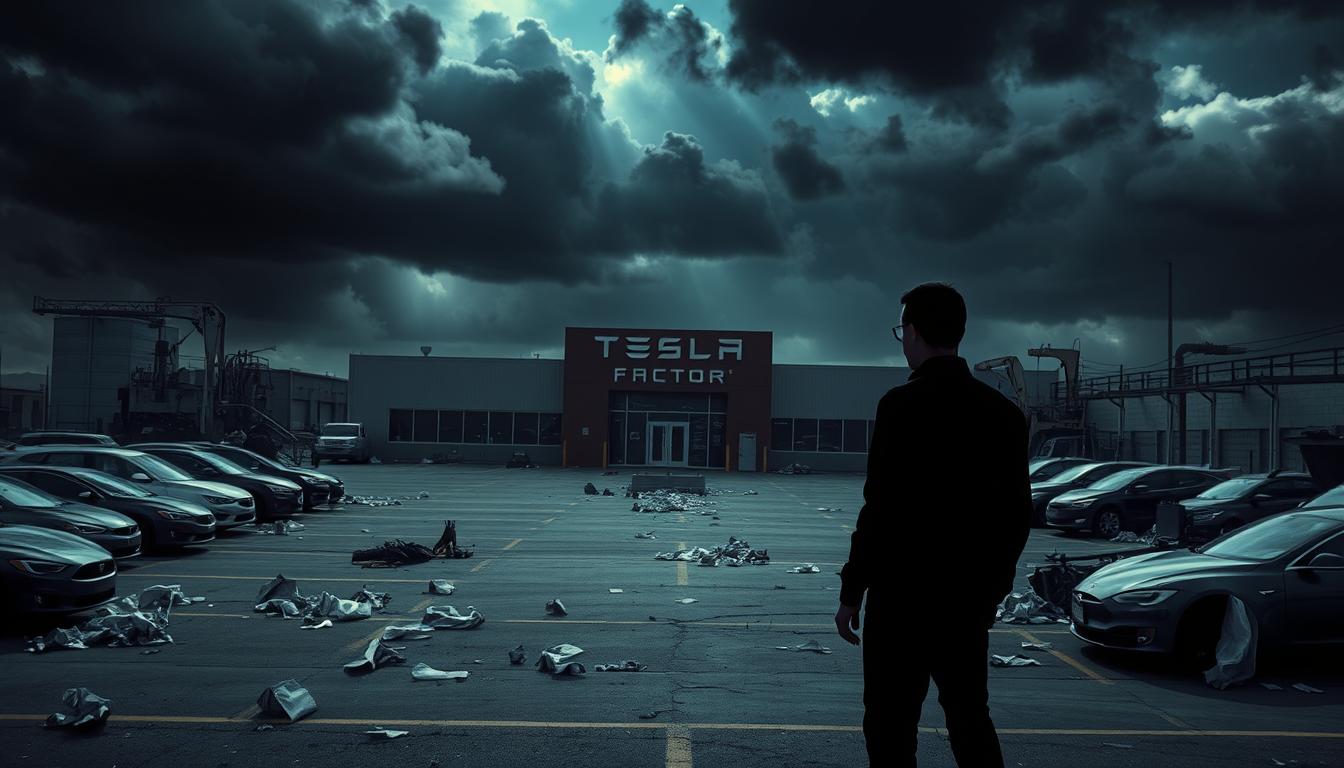
In 2008, Tesla was on the edge of bankruptcy. It had only $9 million left and was facing big financial problems. Elon Musk’s determination and unique strategies were key in saving Tesla from going under.
Tesla’s survival was far from guaranteed. The company had big losses and little cash. But Musk’s leadership and vision helped steer Tesla through this tough time. He prevented financial disaster from happening.
Now, Tesla is thriving. Its market value shows it has overcome past hurdles. The story of Musk saving Tesla is inspiring. It shows the power of innovation and quick action when facing challenges.
The Perfect Storm: Tesla’s Financial Crisis Unfolds
Tesla hit hard times during the global financial crisis. It was tough for the company to find funding. The tesla debt restructuring efforts were slowed down, making things worse. Rumors of tesla bankruptcy spread, adding to the financial woes.
The global financial crisis hit Tesla hard, making it hard to get the funding it needed. The tesla bankruptcy news worried investors, and the stock price took a hit. To grasp the depth of the crisis, we need to look at the main causes.
- Global financial crisis
- Initial business model challenges
- Depletion of initial investments
These issues combined into a perfect storm that threatened Tesla’s future. But Elon Musk’s leadership helped the company survive. Tesla’s ability to adjust and find funding through tesla debt restructuring was key to its survival.
Understanding Tesla’s Pre-2008 Financial Structure
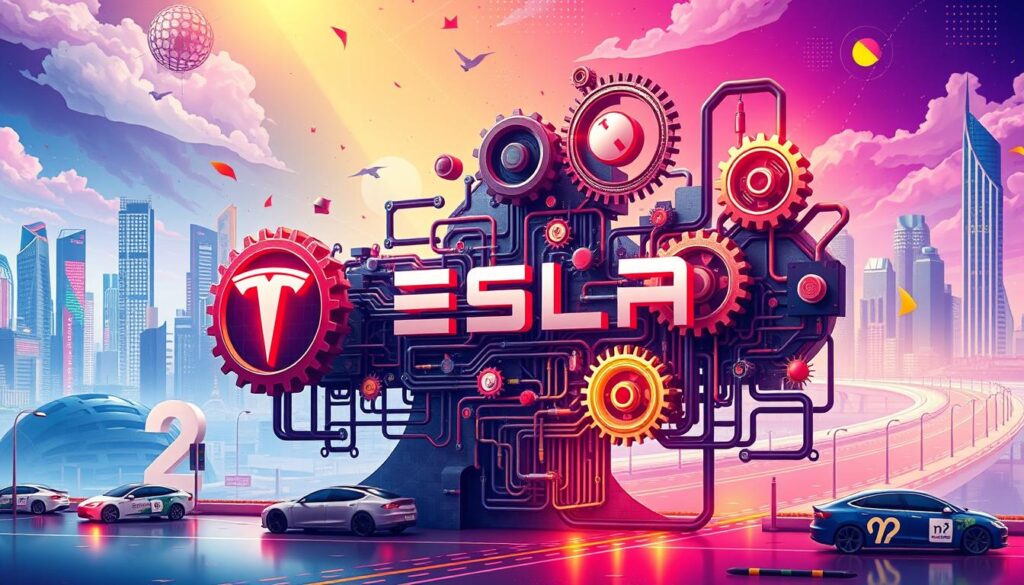
When looking at the tesla bankruptcy implications, it’s key to know about Tesla’s finances before 2008. The company started with big investments, like $6.35 million in Series A funding and $40 million in convertible debt. The first Roadster cost $109,000, and Tesla planned to modify the Lotus Elise. This meant only 7% of parts were shared between the two models.
The tesla bankruptcy analysis shows Tesla had big financial problems, like cash flow issues and delays in production. In 2008, Tesla was in a tough spot, needing to decide how to use its funds. Elon Musk had put $100M of his own money into SpaceX, enough for three rocket launches.
Important points about Tesla’s finances before 2008 include:
* Total private financing by May 2007: $105 million
* Number of staff laid off in January 2008: 10% of the corporation
* Total investment by Musk in Tesla by January 2008: approximately $70 million
* Amount approved in convertible debts by Tesla’s board in November 2008: $40 million
Understanding Tesla’s finances before 2008 helps us see the company’s journey and the tesla bankruptcy implications it faced. The tesla bankruptcy analysis gives us insights into Tesla’s financial battles and how it tried to get through them.
The Brink of Tesla Bankruptcy: December 2008
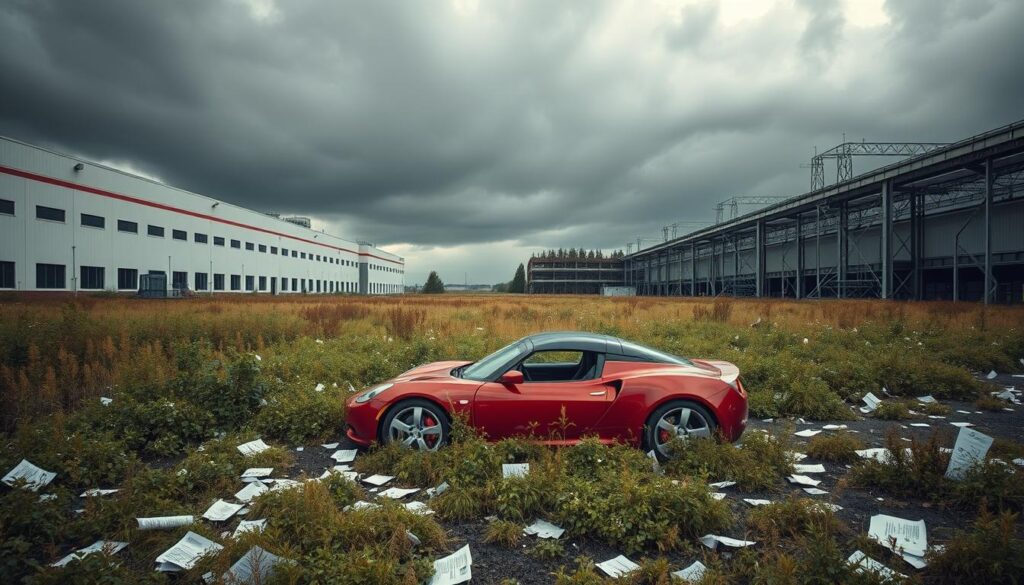
As 2008 ended, Tesla was on the edge of financial disaster. The company was running out of cash fast. By December, Tesla was set to go broke on Christmas Eve, with no money for the next payroll.
Production delays and doubts from the market made things worse. This put Tesla’s future in serious jeopardy.
The tesla financial troubles grew as the need for new money became clear. Musk wanted to raise $20 million in new equity. But, getting all investors to agree was a big challenge.
VantagePoint Capital, led by Alan Salzman, opposed Musk’s plan. This led to a tense negotiation. The success of the funding plan was key to avoiding a tesla bankruptcy filing.
Musk changed his plan to increase debt instead of equity. On Christmas Eve, investors agreed to his new plan. This funding round closed at 6 PM on December 24, 2008, just in time to avoid bankruptcy.
This showed Musk’s leadership and Tesla’s strength. It was a close call, but they made it through.
Elon Musk’s Personal Financial Gamble
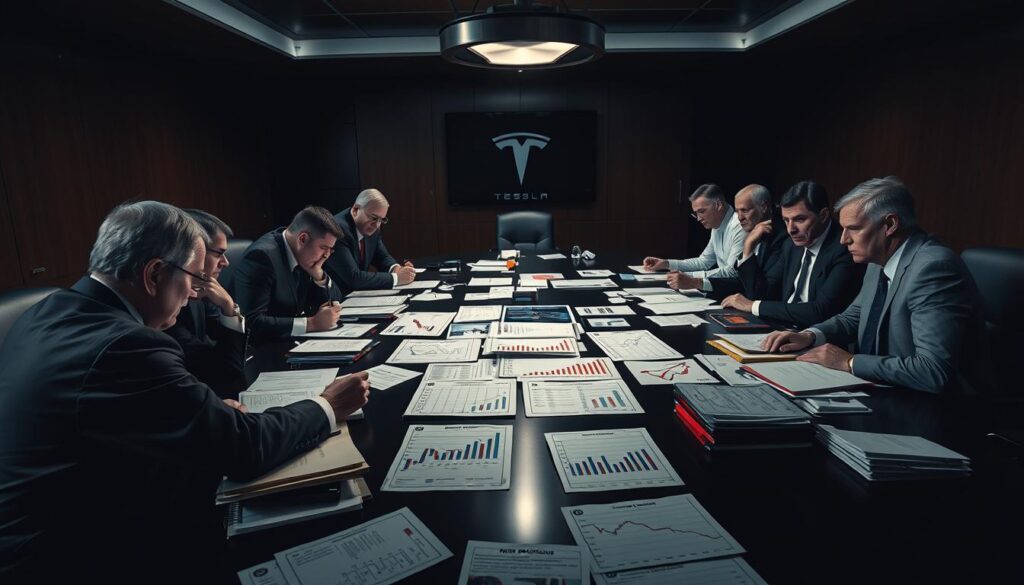
When Tesla’s stock fell, Elon Musk took a big risk. He put in $20 million of his own money. This showed his dedication to Tesla and encouraged others to invest too.
Musk’s goal was to help Tesla deal with its debt. He wanted to make sure the company could keep going.
Musk’s decision was risky, but it paid off. His leadership and vision convinced others to invest. This move helped Tesla’s finances and set the stage for growth.
- Investing $20 million of his own money in Tesla
- Urging other investors to match his stake
- Mitigating risks associated with tesla debt restructuring
- Demonstrating commitment to Tesla’s vision
Musk’s gamble worked, and Tesla recovered. It became a top electric vehicle maker. Musk’s leadership and risk-taking showed his dedication to Tesla’s success.
Critical Decisions That Saved Tesla
When Tesla faced tough times, Elon Musk made key decisions to save the company. In the face of tesla bankruptcy news and tesla bankruptcy rumors, Musk acted fast. He called a Christmas Eve meeting to discuss a plan to keep Tesla afloat.
Musk decided to take on more debt instead of selling more shares. This choice helped Tesla keep control and avoid losing value. With tesla bankruptcy news everywhere, Musk’s quick actions and smart planning were vital. Tesla’s survival shows the importance of smart decisions and creative thinking.
- Emergency funding strategies, such as securing loans from investors and partners
- Operational restructuring, including cost-cutting measures and streamlining production
- Strategic partnerships, which helped Tesla access new markets and technologies
These choices not only saved Tesla but also set it up for success in the future. Looking back at the tesla bankruptcy rumors and Tesla’s growth, Musk’s leadership and vision were key. They shaped Tesla’s future.
The Role of Innovation Under Financial Pressure

When tesla financial troubles hit, companies often turn to innovation to stay afloat. Tesla is a prime example. It used its electric car innovation to survive. Thanks to Musk’s drive and unique strategies, Tesla’s innovative moves were key to its survival.
Several factors helped Tesla succeed:
- Investing in research and development to improve electric car technology
- Expanding product lines to cater to a wider range of customers
- Implementing tesla debt restructuring strategies to manage financial obligations
By embracing innovation and taking risks, Tesla overcame its financial hurdles. It became a leader in electric vehicles. Tesla’s focus on innovation keeps it ahead of competitors and growing.
| Year | Cash Balance | Operating Cash Flow |
|---|---|---|
| 2009 | $70 million | -$81 million |
| 2010 | $226 million | $17 per share |
Key Strategic Pivots During the Crisis
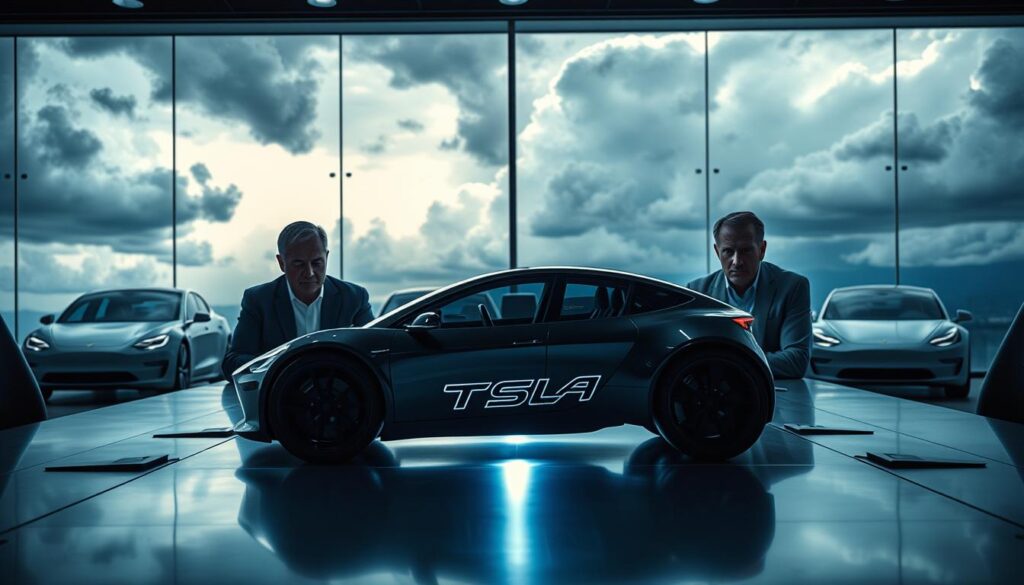
Looking at Tesla’s survival, it’s key to see the strategic moves they made. They changed their production strategy to focus on what they do best. For example, Elon Musk made the Model S a priority, which helped a lot.
Adapting and changing was vital for Tesla’s success. They moved from traditional ads to highlighting their products’ quality. This approach cut down on marketing costs and let them focus on their main products.
Managing resources was also important. Tesla invested in Gigafactories to make their own batteries. This move helped them not rely on others for parts. It also reduced the risk of delays and quality problems. A report on Tesla’s success shows how innovation and adaptability were key.
The table below shows Tesla’s main strategic changes during the crisis:
| Strategic Pivot | Description |
|---|---|
| Production Strategy Changes | Focus on core products, such as the Model S |
| Marketing Adjustments | Shift from traditional advertising to product excellence as a marketing strategy |
| Resource Allocation | Investment in Gigafactories to take control of battery production |
Looking at Tesla’s crisis, it’s clear they survived by adapting and making smart choices. Their moves in production, marketing, and resource use helped them thrive. These decisions made Tesla a leader in the car industry.
External Factors That Influenced Tesla’s Recovery

Looking at Tesla’s recovery, we see the big role of the outside world. The global financial crisis hit hard, causing many car companies to struggle. Tesla was among them, seeing a tesla stock decline in 2008.
The crisis cut car sales sharply. Tesla’s production fell to just 147 vehicles in 2008. It also faced a cash crisis, with only about $9 million left in early 2009. But, the U.S. government gave Tesla a $465 million loan. This helped Tesla bounce back.
By the end of 2010, Tesla’s stock price had soared. It went up over 400% after its public stock offer in June that year.
Several things helped Tesla get back on track:
- Government support through loans and incentives
- Increasing demand for electric vehicles
- Improvements in production efficiency and cost reduction
Tesla’s comeback shows its strength and ability to adapt. With more people wanting electric cars, Tesla is ready to lead the way.
| Year | Tesla’s Stock Price | Production |
|---|---|---|
| 2008 | Decline | 147 vehicles |
| 2010 | Increased by 400% | Improved production efficiency |
Financial Restructuring and Debt Management

Understanding Tesla’s financial struggles is key. The company faced a possible bankruptcy. To avoid disaster, Tesla used tesla debt restructuring like investment rounds and debt consolidation.
Tesla’s efforts paid off, avoiding bankruptcy and even achieving a cash surplus. Its $5 billion long-term debt is much lower than Ford and GM’s. Ford and GM have debts of $140 billion and $115 billion, respectively.
Here’s a comparison of Tesla, Ford, and GM’s debt and market value:
| Company | Long-term Debt | Market Capitalization |
|---|---|---|
| Tesla | $5 billion | $548 billion |
| Ford | $140 billion | $48.23 billion |
| GM | $115 billion | $50.93 billion |
Tesla’s success in managing debt shows its smart financial moves. This proves the company’s ability to handle its finances well.
The Christmas Eve Miracle: Last-Minute Funding
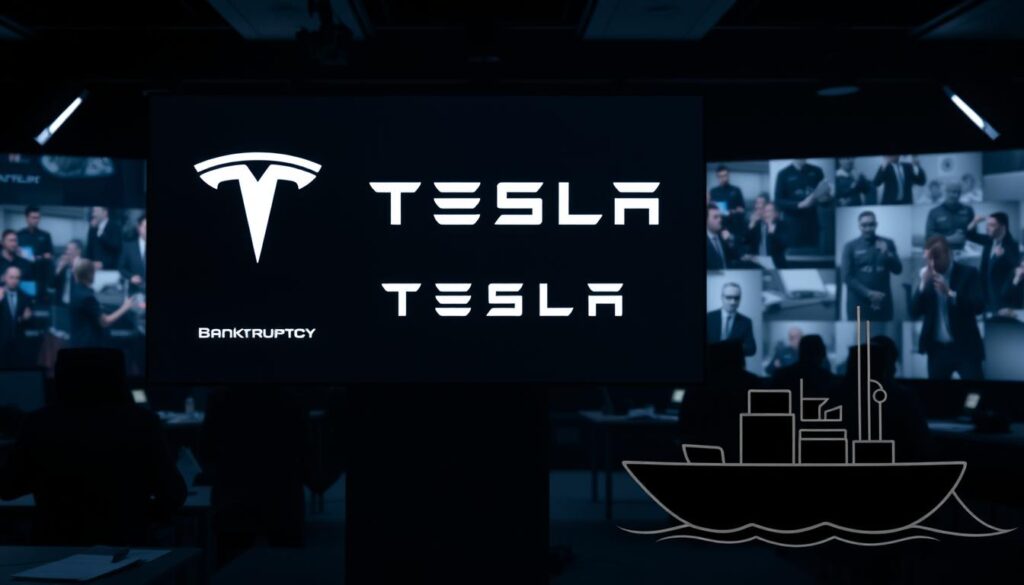
As tesla bankruptcy news and tesla bankruptcy rumors spread, Tesla’s future was uncertain. But on Christmas Eve 2008, everything changed. The company got $80 million in funding, a move that saved it from bankruptcy.
This funding was a game-changer for Tesla. It allowed the company to keep going and change the car world. Elon Musk and investors worked hard to make this happen.
The funding showed Tesla’s worth and the faith of its backers. It also silenced tesla bankruptcy rumors and lifted everyone’s spirits.
Some key facts about the funding include:
- Tesla secured $80 million in funding on Christmas Eve 2008
- The funding was a result of a critical meeting that took place on Christmas Eve
- Elon Musk and other investors worked tirelessly to secure the necessary funds
The Christmas Eve funding was a miracle for Tesla. It was a turning point in the company’s history. Tesla could then focus on making electric cars for everyone.
| Year | Funding | Investors |
|---|---|---|
| 2008 | $80 million | Elon Musk and other investors |
| 2009 | $50 million | Daimler |
Lessons from Tesla’s Near-Death Experience
Looking back at Tesla’s journey, we see valuable lessons from its near-death experience in 2008. One key lesson is the importance of effective risk management, which is critical during financial uncertainty. Tesla’s ability to manage tesla financial troubles and restructure its debt was key to its survival.
Risk Management Insights
Tesla’s story teaches us the value of proactive risk management. This includes diversifying income, managing cash flow, and having a flexible business model. These steps help companies weather economic downturns and unexpected challenges.
Leadership Under Pressure
Elon Musk’s leadership during Tesla’s crisis was vital to its recovery. His vision and team motivation were key in securing funding and driving innovation. This shows the critical role of strong leadership in crisis times.
Innovation During Crisis
Innovation was also key to Tesla’s recovery. The company’s focus on new products and technologies kept it competitive and attracted investors. This shows the importance of innovation, even when finances are tight.
| Year | Revenue | Vehicle Deliveries |
|---|---|---|
| 2009 | $14 million | 2,500 |
| 2014 | $3.2 billion | 31,000 |
| 2021 | $53.8 billion | 936,000 |
By learning from Tesla’s near-death experience, companies can develop strategies to overcome their own financial hurdles. This includes focusing on risk management, leadership, and innovation for long-term success.
Tesla’s Post-Crisis Transformation
After hitting hard times, Tesla has made a stunning comeback. The company’s growth is thanks to its ability to adjust to new market trends and its focus on innovation.
Now, Tesla is one of the top car companies globally, with a value over $500 billion. This is a big win, given its past financial hurdles. Key factors in Tesla’s success include:
- Strategic investments and partnerships, such as the $50 million from Daimler in 2009
- Successful product launches, like the Model 3, which started selling big in 2019
- Operational efficiencies and cost cuts, leading to its first quarterly profit
Tesla’s journey shows the strength of innovation and resilience. Despite tough times, including a stock drop, Tesla has come out stronger and more competitive.
Conclusion: The Legacy of Tesla’s 2008 Survival Story
The story of Tesla’s survival in 2008 has changed the car industry forever. Elon Musk’s big risk and Tesla’s smart moves during that time helped the company grow. The implications of Tesla’s bankruptcy scare have made electric cars more popular around the world.
Tesla’s ability to keep going and innovate under tough times has inspired many. The lessons from Tesla’s 2008 bankruptcy analysis show the importance of staying strong, planning ahead, and pushing for new tech. Even if your business isn’t in crisis, learning from Tesla’s journey can help you get through tough times.
The electric car movement is growing, and Tesla’s 2008 story is a big part of it. It shows how innovation, leadership, and a focus on a green future can change the world. The future may have ups and downs, but Tesla’s story will keep inspiring new leaders in the car industry.

 Tesla Bankruptcy: How Elon Musk Saved the Company in 2008
Tesla Bankruptcy: How Elon Musk Saved the Company in 2008
0 Comment